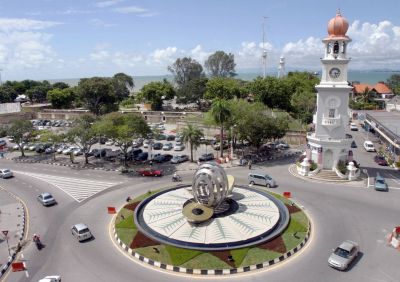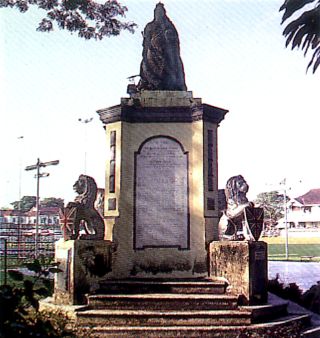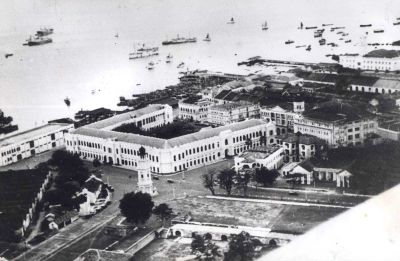 Cleaned up good: An aerial view of the 4.8m-tall metal structure resembling pinang fruits at the roundabout next to the clock tower at King Edward’s Place.
Cleaned up good: An aerial view of the 4.8m-tall metal structure resembling pinang fruits at the roundabout next to the clock tower at King Edward’s Place. THE British colonial officers who came to Penang must have missed their country very much judging by the number of roads on the island that have been named after some notable places and roads in London.
In fact, if you have a friend from the UK visiting the country, you should include this “home-away-from-home” tour on his itinerary. He will surely be much amused, and exclaim, “Blimey!”
Topping the list must be Buckingham Street within George Town’s Unesco World Heritage site in the inner city.
It runs from Pitt Street or Jalan Masjid Kapitan Keling to the junction of Campbell Street and Carnarvon Street.
Buckingham Street is of course named after the Buckingham Palace in London, the official residence of the British monarch.
 Tribute: The Queen Victoria Memorial at the Chinese Recreation Club was completed only after she passed away.
Tribute: The Queen Victoria Memorial at the Chinese Recreation Club was completed only after she passed away. The street in Penang got its identity at the turn of the 20th century. Among Penangites, Buckingham Street is known in Hokkien as sin kay thau meaning the “beginning of the new street.”
Buckingham Street was said to have been created when the Municipal Council of George Town bought land back from the estate of the Kapitan Keling Mosque to build roads, the Campbell Street market and the Carnarvon Street police station.
Despite its somewhat prestigious name, the street today offers nothing outstanding, other than its intrinsic heritage value. Most of the shops, which are located in pre-war colonial houses, have been closed.
But the property value of these shoplots has shot up because of the demand for such heritage homes.
Another high-sounding street with British origin is, of course, Downing Street.
Like its real counterpart in London, it was also the street of Government, with most of the government offices sited there.
According to Penang historian and publisher Khoo Salma Nasution, these offices were erected in stages from 1889.
The first block housed the Resident Councillor’s Office, the Audit Office, the Public Works Department, the Marine Department and the Harbour Master’s Office.
 Passing ships: An aerial view of the government quadrangle at King Edward’s Place and Weld Quay taken on Feb 19, 1937.
Passing ships: An aerial view of the government quadrangle at King Edward’s Place and Weld Quay taken on Feb 19, 1937. Also on the same road was the Chinese Protectorate and Indian Immigration Depot that processed the thousands of immigrants that came through Penang’s port.
In London, the most famous address on Downing Street is No 10, which is both home and office for the British Prime Minister.
The PM’s immediate neighbours are the first Lord of the Treasury (equivalent to our Finance Minister) who stays at No 11, and Government’s Chief Whip who is at No 12. This has been the tradition for the past 200 years.
But the street itself goes further back, and was built in the 1680s by Sir George Downing, who was a soldier, property investor and diplomat serving under King Charles II.
During the Second World War, the Japanese came down hard on Penang’s Downing Street, and all its buildings, except for one, were destroyed.
After we gained independence, it was decided that the seat of government should remain on the same road, but a new building, the Bangunan Tuanku Syed Putra, was built.
The foundation stone was laid by our first Prime Minister Tunku Abdul Rahman, and the building was completed and opened in 1962 by Raja Tun Uda, the firstPenang Governor. In the 1980s, the seat of government was transferred to Komtar.
The British officers in charge of naming the streets were not only thinking about their monarch and government back home, but also entertainment.
Thus, we also have Drury Lane in Penang, which is named after the same street in the West End, where the theatres are located.
The Theatre Royal, Drury Lane, commonly known as Drury Lane, is located near Covent Garden. Dating back to 1663, it is the oldest theatre site in London.
According to Khoo, Drury Lane was very much a part of Old Penang because it was Penang’s West End with the locals calling it sin hi tai or new theatre.
Interestingly enough, the adjoining Kuala Kangsar Road was known as Bangsawan Street.
The theatre was rented by the Chinese for their opera and the Malays for the bangsawan, which catered to the Malay aristocrat, she wrote.
There is also Cheapside, off Chulia Street, which, like its London namesake, was the place where the stalls and shops sold mainly hardware and household items.
Both Buckingham Street and Cheapside have a personal attachment for me as I spent a lot of time there as a child.
My grandmother’s home was at 9, Cheapside, where my father ran a hardware stall at the entrance of the road.
I would often run off to nearby Seck Chuan Lane and Buckingham Street to escape from my grandmother, running through the myriad of alleys in the vicinity.
Come the Hungry Ghost Festival, a small open area would be converted into a stage for Chinese opera, comprising mostly of Teochew-speaking actors and musicians from southern Thailand.
The narrow alley, Cheapside, in Penang is named after London’s Cheapside which was a poultry market in medieval England. Cheap, in medieval English, roughly meant market.
London’s Cheapside evolved into a flea market in modern times and today, it has become a fashionable area with retail and food outlets.
Both Penang and London also have Church Street. The one in London is situated in central London, next to West End, Hyde Park, Regent’s Park and St John’s Wood.
In Penang, Church Street is so named because the first church of the Portuguese Eurasians was built there, according to Khoo’s Streets of Georgetown.
Khoo wrote Church Street is still remembered as ghee hin kay because the Ghee Hin secret society was based there for almost a century although the premises was subsequently taken over by the leader of the rival Hai San secret society.
Church Street is just a stone’s throw away from The Star office in Pitt Street now called Jalan Masjid Kapitan Keling, again a personal attachment for this writer.
Another street that deserves a mention is King Edward’s Place. There may not be another similar street name in London but this short street within the heritage site is named after Edward VII, who reigned from 1901 until his death in 1910.
It is believed that this road, which was created at the turn of the 20th century, was built on reclaimed land.
Before that, there was a government jetty called Victoria Pier at the end of nearby Light Street, according to a Wikipedia entry.
A prominent landmark here is the Victoria Memorial Clock Tower which was built to commemorate the Diamond Jubilee of Queen Victoria in 1897. It is 60ft tall, one foot for every year of the Queen’s reign, and was built by local millionaire and businessman Cheah Chen Eok.
Incidentally, there is also another monument to celebrate the Victorian era located at Victoria Green, which is the playing field of the Chinese Recreation Club.
Here, a statue of Queen Victoria stands majestically at the Pangkor Road-Burmah Road junction of Victoria Green. It was only completed in 1930, long after the queen had passed on.
There is no denying that the British left an enduring physical legacy in Penang simply through the naming of roads and the construction of buildings and monuments.
Many present-day Penangites may not really know the full history, but visitors from Britain will surely have a smile on their face each time they walk these streets, or pause to take a picture of the icons that remind them so much of home.
One can imagine an elderly Briton telling his grandson, next to the Queen Victoria statue, “You know, our Queen Elizabeth is the great-great-granddaughter of Victoria.”
To which the young lad will exclaim, “Crickey!”
> If you have queries on the streets of Penang, or want to share your own snippets, email to mystory@thestar.com.my





